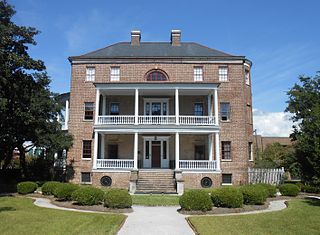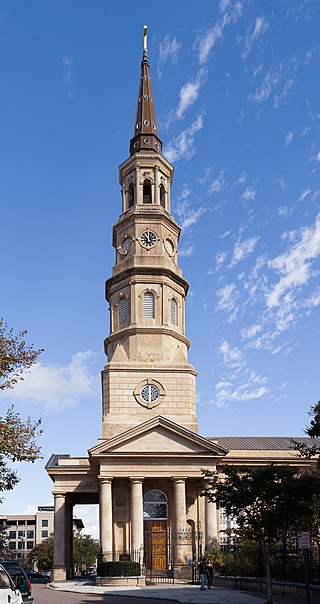
Robert Mills was a South Carolina architect known for designing both the first Washington Monument, located in Baltimore, Maryland, as well as the better known monument to the first president in the nation's capital, Washington, DC. He is sometimes said to be the first native-born American to be professionally trained as an architect. Charles Bulfinch of Boston perhaps has a clearer claim to this honor.

The Smithsonian Institution Building, more commonly known as the Smithsonian Castle or simply The Castle, is a building on the National Mall housing the Smithsonian Institution's administrative offices and information center. Built as the first Smithsonian museum building, it is constructed of Seneca red sandstone in the Norman Revival style. It was completed in 1855 and designated a National Historic Landmark in 1965.

The Charles Pinckney National Historic Site is a unit of the United States National Park Service, preserving a portion of Charles Pinckney's Snee Farm plantation and country retreat. The site is located at 1254 Long Point Road, Mount Pleasant, South Carolina. Pinckney (1757-1824) was a member of a prominent political family in South Carolina. He fought in the American Revolutionary War, was held for a period as prisoner in the North, and returned to the state in 1783. Pinckney, a Founding Father of the United States, served as a delegate to the constitutional convention where he contributed to drafting the United States Constitution.

Hibernian Hall is a historic meeting hall and social venue at 105 Meeting Street in Charleston, South Carolina, United States. Built in 1840, it is Charleston's only architectural work by Thomas Ustick Walter, and a fine example of Greek Revival architecture. The wrought iron gates were made by Christopher Werner, a German-American master ironworker in Charleston.

The City Market is a historic market complex in downtown Charleston, South Carolina. Established in the 1790s, the market stretches for four city blocks from the architecturally-significant Market Hall, which faces Meeting Street, through a continuous series of one-story market sheds, the last of which terminates at East Bay Street. The market should not be confused with the Old Slave Mart where enslaved people were sold, as enslaved people were never sold in the City Market. The City Market Hall has been described as a building of the "highest architectural design quality." The entire complex was listed on the National Register of Historic Places as Market Hall and Sheds and was further designated a National Historic Landmark.

The William Aiken House and Associated Railroad Structures make up a National Historic Landmark District in Charleston, South Carolina, that contains structures of South Carolina Canal and Railroad Company and the home of the company's founder, William Aiken. These structures make up one of the largest collection of surviving pre-Civil War railroad depot facilities in the United States. The district was declared a National Historic Landmark in 1963.

The Market House is a Market house and town hall in the center of Fayetteville, Cumberland County, North Carolina. It was built in 1838 on the site of the old state house and Town Hall which burned down in 1831. Fayetteville was the capital of North Carolina from 1789 to 1794.

Lancaster County Courthouse is a historic courthouse in Lancaster, South Carolina. Built in 1828, it has been in continuous use since then. It was designated a National Historic Landmark in 1973, as a possible work of Robert Mills, an important American architect of the first half of the 19th century. It also has the distinction of being the site of the last witch trials to take place in the United States.

The Old Exchange & Provost Dungeon, also known as the Custom House, and The Exchange, is a historic building at East Bay and Broad Streets in Charleston, South Carolina. Built in 1767–1771, it has served a variety of civic institutional functions, including notably as a prisoner of war facility operated by British forces during the American Revolutionary War. The building was designated a National Historic Landmark in 1973. It is now a museum operated by the Daughters of the American Revolution.

The Charleston Historic District, alternatively known as Charleston Old and Historic District, is a National Historic Landmark District in Charleston, South Carolina. The district, which covers most of the historic peninsular heart of the city, contains an unparalleled collection of 18th and 19th-century architecture, including many distinctive Charleston "single houses". It was declared a National Historic Landmark in 1960.

Hampton Plantation, also known as Hampton Plantation House and Hampton Plantation State Historic Site, is a historic plantation, now a state historic site, north of McClellanville, South Carolina. The plantation was established in 1735, and its main house exhibits one of the earliest known examples in the United States of a temple front in domestic architecture. It is also one of the state's finest examples of a wood frame Georgian plantation house. It was declared a National Historic Landmark in 1970.

Kahal Kadosh Beth Elohim is a Reform Synagogue located in Charleston, South Carolina. Having founded the congregation in 1749, it was later claimed to be the first Reform synagogue located in the United States, the current 1841 synagogue was built by enslaved African descendants owned by David Lopez Jr, a prominent slaveowner and proponent of the Confederate States of America, after the original synagogue was destroyed in a fire in 1838. It is one of the oldest Jewish congregations in the United States. The congregation is nationally significant as the place where ideas resembling Reform Judaism were first evinced. It meets in an architecturally significant 1840 Greek Revival synagogue located at 90 Hasell Street in Charleston, South Carolina. It was designed by Cyrus L. Warner.

The Joseph Manigault House is a historic house museum in Charleston, South Carolina that is owned and operated by the Charleston Museum. Built in 1803, it was designed by Gabriel Manigault to be the home of his brother, and is nationally significant as a well-executed and preserved example of Adam style architecture. It was declared a National Historic Landmark in 1973.

St. Michael's AnglicanChurch is a historic church and the oldest surviving religious structure in Charleston, South Carolina. It is located at Broad and Meeting streets on one of the Four Corners of Law, and represents ecclesiastical law. It was built in the 1750s by order of the South Carolina Assembly. It is listed on the National Register of Historic Places and is a National Historic Landmark.

The Powder Magazine is a gunpowder magazine and museum at 79 Cumberland Street in Charleston, South Carolina, USA. Completed in 1713, it is the oldest surviving public building in the former Province of Carolina. It was used as a gunpowder store through the American Revolutionary War, and later saw other uses. The Powder Magazine was declared a National Historic Landmark in 1989. It has been operated as a museum by the National Society of the Colonial Dames of America since the early 1900s. It was designated a National Historic Landmark in 1972.

The Robert Barnwell Rhett House is a historic house at 6 Thomas Street in Charleston, South Carolina. A National Historic Landmark, it is significant as the home of Robert Barnwell Rhett, a leading secessionist politician. He opposed John C. Calhoun to lead the Bluffton Movement for separate state action on the Tariff of 1842. Rhett was one of the leading fire-eaters at the Nashville Convention of 1850, which failed to endorse his aim of secession.

St. Philip's Church is an historic church at 142 Church Street in Charleston, South Carolina. Its National Historic Landmark description states: "Built in 1836, this stuccoed brick church features an imposing tower designed in the Wren-Gibbs tradition. Three Tuscan pedimented porticoes contribute to this design to make a building of the highest quality and sophistication." On November 7, 1973, it was added to the National Register of Historic Places and designated a National Historic Landmark.

This is a list of the National Register of Historic Places listings in Charleston County, South Carolina.

The South Carolina Historical Society is a private, non-profit organization founded in 1855 to preserve South Carolina's rich historical legacy. The SCHS is the state's oldest and largest private repository of books, letters, journals, maps, drawings, and photographs about South Carolina's history.























